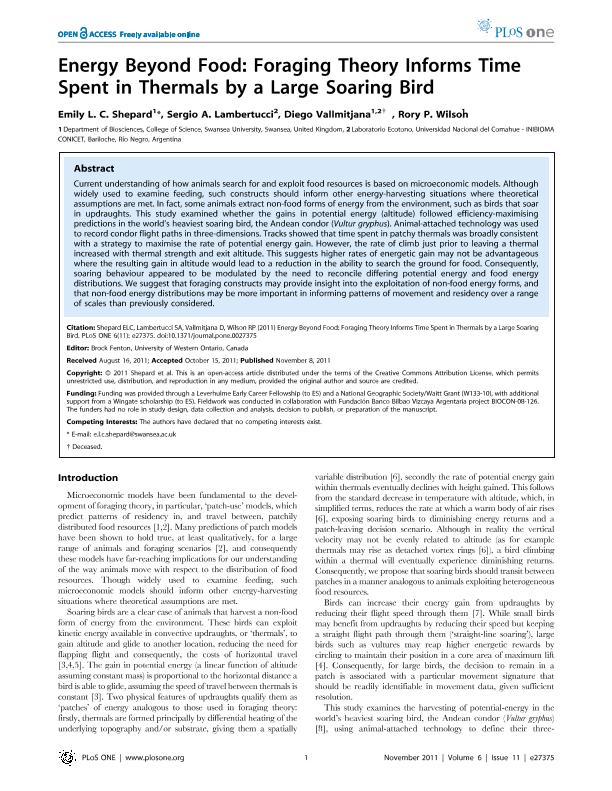Mostrar el registro sencillo del ítem
dc.contributor.author
Shepard, Emily L. C.
dc.contributor.author
Lambertucci, Sergio Agustin

dc.contributor.author
Vallmitjana, Diego
dc.contributor.author
Wilson, Rory P.

dc.date.available
2019-04-26T18:24:53Z
dc.date.issued
2011-11
dc.identifier.citation
Shepard, Emily L. C.; Lambertucci, Sergio Agustin; Vallmitjana, Diego; Wilson, Rory P.; Energy beyond food: Foraging theory informs time spent in thermals by a large soaring bird; Public Library of Science; Plos One; 6; 11; 11-2011; 1-6; e27375
dc.identifier.issn
1932-6203
dc.identifier.uri
http://hdl.handle.net/11336/75133
dc.description.abstract
Current understanding of how animals search for and exploit food resources is based on microeconomic models. Although widely used to examine feeding, such constructs should inform other energy-harvesting situations where theoretical assumptions are met. In fact, some animals extract non-food forms of energy from the environment, such as birds that soar in updraughts. This study examined whether the gains in potential energy (altitude) followed efficiency-maximising predictions in the world's heaviest soaring bird, the Andean condor (Vultur gryphus). Animal-attached technology was used to record condor flight paths in three-dimensions. Tracks showed that time spent in patchy thermals was broadly consistent with a strategy to maximise the rate of potential energy gain. However, the rate of climb just prior to leaving a thermal increased with thermal strength and exit altitude. This suggests higher rates of energetic gain may not be advantageous where the resulting gain in altitude would lead to a reduction in the ability to search the ground for food. Consequently, soaring behaviour appeared to be modulated by the need to reconcile differing potential energy and food energy distributions. We suggest that foraging constructs may provide insight into the exploitation of non-food energy forms, and that non-food energy distributions may be more important in informing patterns of movement and residency over a range of scales than previously considered.
dc.format
application/pdf
dc.language.iso
eng
dc.publisher
Public Library of Science

dc.rights
info:eu-repo/semantics/openAccess
dc.rights.uri
https://creativecommons.org/licenses/by-nc-sa/2.5/ar/
dc.subject
Energy
dc.subject
Fly
dc.subject
Thermals
dc.subject
Foraging Theory
dc.subject.classification
Otras Ciencias de la Tierra y relacionadas con el Medio Ambiente

dc.subject.classification
Ciencias de la Tierra y relacionadas con el Medio Ambiente

dc.subject.classification
CIENCIAS NATURALES Y EXACTAS

dc.title
Energy beyond food: Foraging theory informs time spent in thermals by a large soaring bird
dc.type
info:eu-repo/semantics/article
dc.type
info:ar-repo/semantics/artículo
dc.type
info:eu-repo/semantics/publishedVersion
dc.date.updated
2019-04-23T15:05:10Z
dc.journal.volume
6
dc.journal.number
11
dc.journal.pagination
1-6; e27375
dc.journal.pais
Estados Unidos

dc.journal.ciudad
San Francisco
dc.description.fil
Fil: Shepard, Emily L. C.. Swansea University; Reino Unido
dc.description.fil
Fil: Lambertucci, Sergio Agustin. Consejo Nacional de Investigaciones Científicas y Técnicas. Centro Científico Tecnológico Conicet - Patagonia Norte. Instituto de Investigaciones en Biodiversidad y Medioambiente. Universidad Nacional del Comahue. Centro Regional Universidad Bariloche. Instituto de Investigaciones en Biodiversidad y Medioambiente; Argentina
dc.description.fil
Fil: Vallmitjana, Diego. Swansea University; Reino Unido. Consejo Nacional de Investigaciones Científicas y Técnicas. Centro Científico Tecnológico Conicet - Patagonia Norte. Instituto de Investigaciones en Biodiversidad y Medioambiente. Universidad Nacional del Comahue. Centro Regional Universidad Bariloche. Instituto de Investigaciones en Biodiversidad y Medioambiente; Argentina
dc.description.fil
Fil: Wilson, Rory P.. Swansea University; Reino Unido
dc.journal.title
Plos One

dc.relation.alternativeid
info:eu-repo/semantics/altIdentifier/doi/http://dx.doi.org/10.1371/journal.pone.0027375
dc.relation.alternativeid
info:eu-repo/semantics/altIdentifier/url/https://journals.plos.org/plosone/article?id=10.1371/journal.pone.0027375
Archivos asociados
